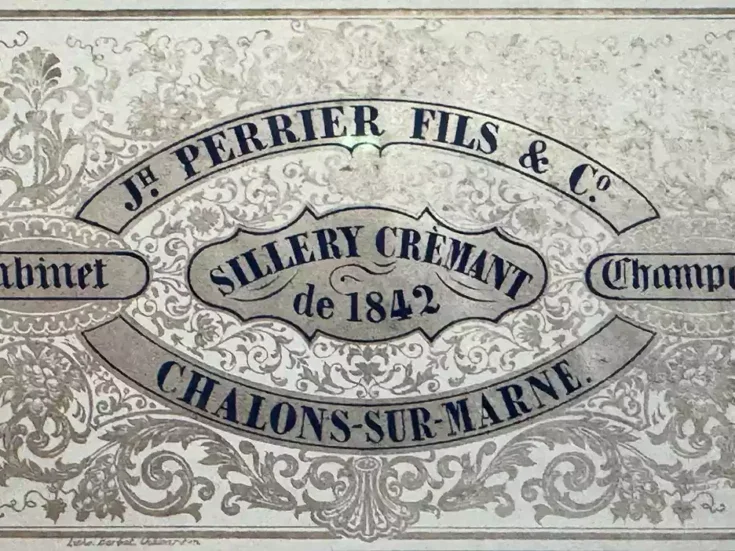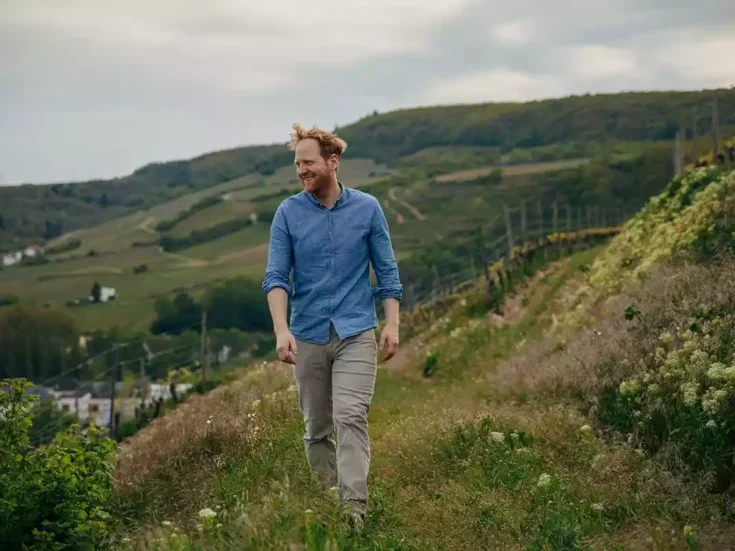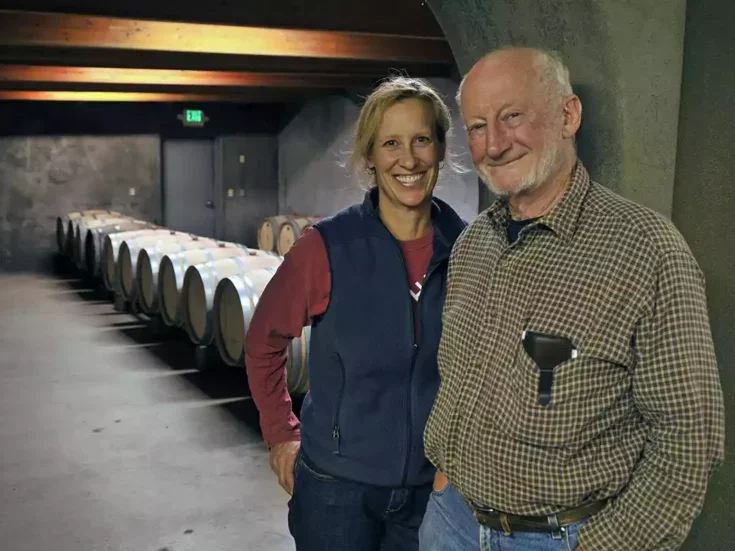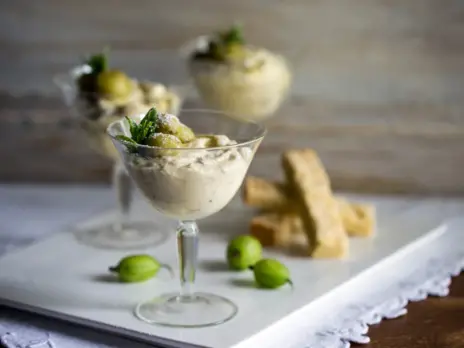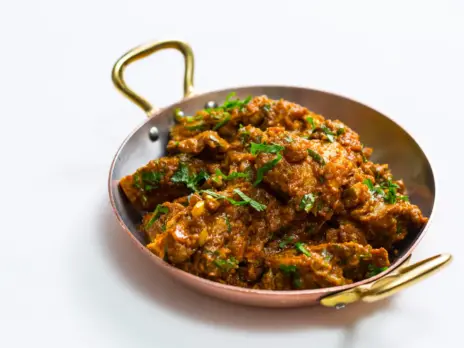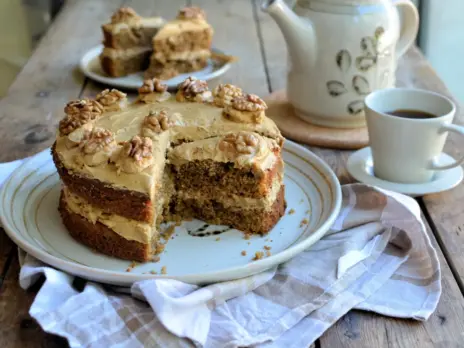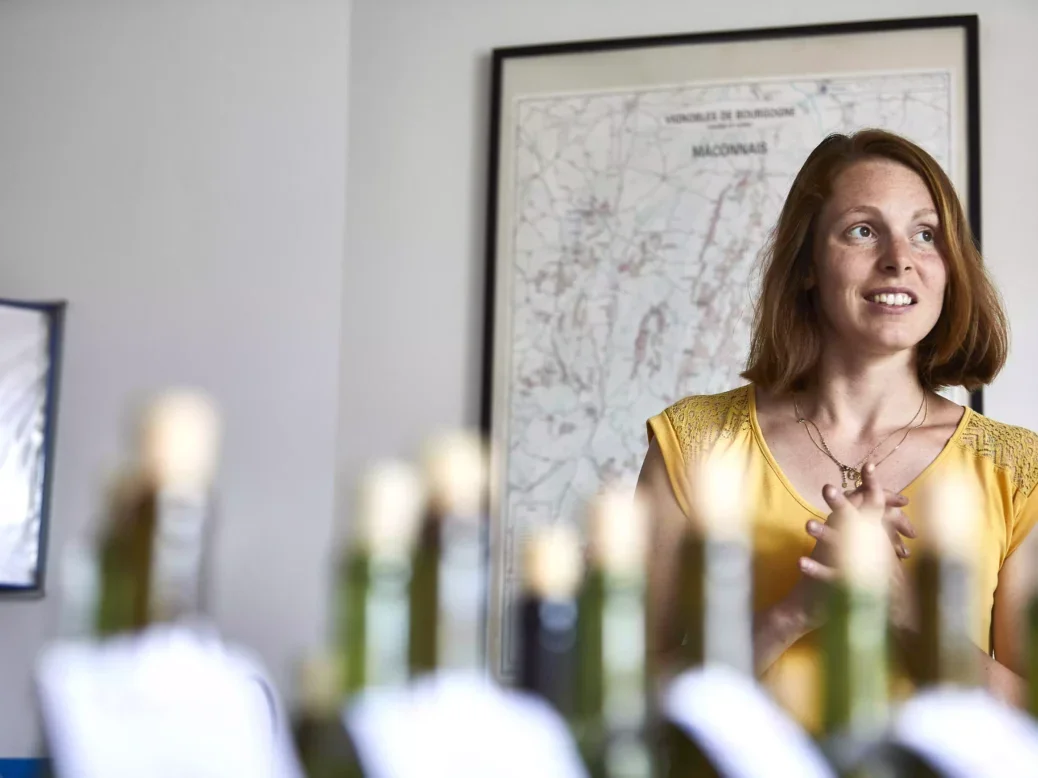
Sarah Marsh MW reports from an instructive tasting at Château Bellevue in Morgon.
There is so much to discover in Beaujolais, so much diversity,” says Elodie Rousselot, winemaker at Château (de) Bellevue in Morgon.
It’s easy to think of Beaujolais as simply “Gamay on granite,” but a new generation of wine producers are exploring the full potential of the terroir, intent on expressing the differences not only within the ten crus of Beaujolais but also parcels within lieux-dits within climats. They are exploring the character of pockets of vines where the soil, aspect, and altitude are unique. “So many different terroirs,” enthuses Elodie, who tastes regularly with fellow winemakers to consider which of these parcels have the potential to become premier cru. “It brings us together and makes us think about the terroir we have.”
Between 2009 and 2018, at the request of the Interprofession des Vins du Beaujolais, the Sigales soil-research consultancy conducted a field study in collaboration with the Rhône Chamber of Agriculture and SICAREX (Beaujolais wine-research center) to establish a precise map of the vineyards.
About half of the decomposed shale soil of the Beaujolais region is composed of granite, one third of blue stone, and the balance is of Piedmont deposits. One thousand pits were dug to investigate the bedrock, on the premise that 99% of the soil in a vineyard is derived from the parent material. “During the study, soil scientists and geologists identified up to 300 different soil types.” Elodie is clearly excited by the opportunity this offers.
The wide variety of soils was then grouped into “soil classes” and used to create several maps, more or less simplified. The most commonly used ones describe Beaujolais soils in 15–25 categories.
The excellent map of the Morgon cru illustrates how the granite dominates specific areas, while blue stone is more prominent elsewhere. “The blue stone with clay warms up more slowly than granite, so this terroir is cooler,” Elodie explains. She finds that “the blue stone provides elegance.”
Toward the south of the region, limestone takes over, and here you find vineyards of Pinot Noir and Chardonnay used largely for the production of crémant. Increasingly, however, growers recognize the potential to make original, terroir-driven still wines. In 2017, Maison Jean Loron, which owns Château Bellevue, planted 2ha (5 acres) of Chardonnay on pierres dorées, a clay-limestone soil that can be traced back 172 million years.
Reflection of terroir, as we all know, is the ultimate goal in Burgundy, but as Elodie observes, “Unfortunately, in Beaujolais the diversity of winemaking has a big impact on the wines, and it can be difficult to find the terroir—although this is changing.”
On the terroir trail
At Château Bellevue, the approach in the vineyard and winery has evolved since Maison Jean Loron bought the property in 2009. Immediately, they decided to concentrate on the best parcels within the estate’s 35ha (85 acres) of vineyard—16ha (40 acres) in Morgon and 3ha (7.5 acres) in Fleurie. “Tristan Larsen, my predecessor, together with Frédéric Maignet, technical director of Maison Jean Loron, began the work to better understand the appellation’s terroir,” says Elodie. “The meticulousness of the work carried out in vinifying the different parcels is impressive, and I’m doing my best to continue in this vein.
“Morgon is a complex, varied, and relatively vast cru. A better understanding of our terroir has enabled us to approach the most accurate phenolic ripeness possible in each parcel. That’s why, across our 16ha of Gamay vines, the harvest is spread over two full weeks. Vines on south-facing granite need to be picked very early, and other vines much higher up on heavy soils need to be picked later.”
Staying with the vineyard for a moment, more recent changes include the use of cover crops in young vineyards to control vigor and the introduction of an electric high-clearance tractor and electric trimming machine that, I am told, enables more precise work between the vines, as well as reducing the estate’s consumption of fossil fuel.
In 2009, the winery was completely reequipped, which included installing temperature-controlled tanks. “Tristan Larsen implemented a drastic reduction in the doses of SO2 used throughout the vinification and aging of the wines,” adds Elodie. Later, Larsen began to reduce extraction. “I think the biggest changes in winemaking began around the 2019 vintage, and this shift is particularly marked on the Morgon Les Charmes.”
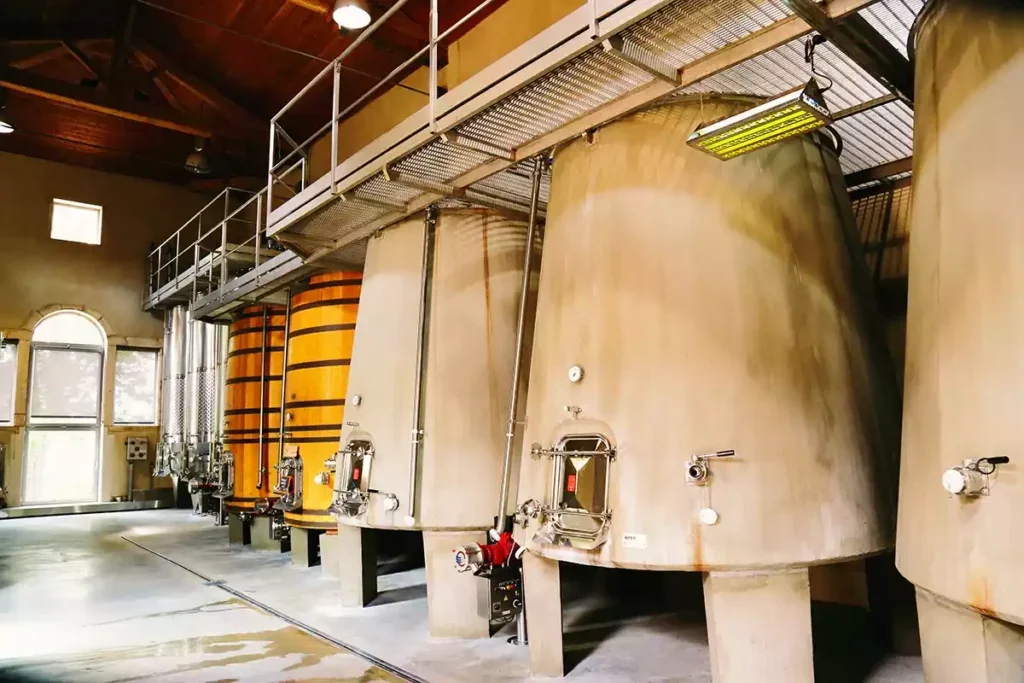
We tasted a magnum of 2015 Morgon Les Charmes, which was deliciously fruity and rich. A bold wine, but sadly it lacked freshness and finish. Elodie observes, “2015 was an exceptionally hot, dry year, from spring to harvest. This Charmes is a reflection of its vintage—warm, structured, and powerful.”
Nevertheless, a warm vintage such as 2015 would be handled differently now, to retain more freshness. “I think that with climate change we must work with less extraction, and most of the wines are aged in tank, because I want to keep the freshness.” Only Javenières and Corcelette Le Clos still have some barrel-aging.
The winemaking really changed direction for the 2022 vintage, when Elodie joined Château Bellevue. She grew up 50 miles (80km) north of Dijon and studied at the Lycée Viticole in Beaune. An enology degree in Dijon included a work/study program at Louis Jadot, after which she clocked up some New World experience in Chile’s Maipo Valley, Napa, and Barossa.
Having settled in Morgon for the 2022 vintage, Elodie pulled back on extraction at Château Bellevue and modified the élevage. Furthermore, she has reduced the vatting period. For Fleurie and Charmes, this is now just 10–12 days, and for Côte du Py and Javernières, 21 days. She uses 20% whole-bunch for most of the cuvées. The Fleurie, however, is totally destemmed, and in 2022 there were 70% whole bunches for Javernières, “to help adapt to the richer vintage,” she says.
She describes her approach as “pretty low-intervention because we have well-structured berries. I pump over twice a day and also use grids to keep the cap under the juice, making it more of an infusion. At the end, I do a little pigeage to release the sugar and to keep the fermentation going.
“We still have a lot of very old vines planted at very high densities, which produce powerful wines without thorough extraction or maceration. Another factor in the structure of our wines is the low yields. Our vines produce about 40hl/ha.”
Elodie sums up: “I think that the phrase that best describes Bellevue, and that has driven the evolution of our winemaking style, is ‘a better understanding of our terroir.’”
I couldn’t help but notice that Elodie refers to Burgundy and Beaujolais as separate entities rather than as part of a collective whole. I confess that over many years of reviewing Burgundy, I have spent limited time in Beaujolais on the basis that the soil and variety are different. These days, however, there is far greater interest in the wines of wider Burgundy. Beaujolais is producing terroir-given wines that deserve to be taken seriously, while not forgetting that you can still have fun with Beaujolais. I’m not talking about quaffing Beaujolais Nouveau, but enjoying a fruit-driven wine such as Château Bellevue Fleurie, which calls for immediate drinking and needs no aging.
Elodie is bottling a few magnums of Morgon Les Charmes—not too many, as she says it’s still difficult to sell magnums of Beaujolais—but I agree completely with her that “for a celebration or festive occasion, these magnums are great value and good fun.”
Tasting
2019 Château Bellevue Fleurie Montgenas
This steep, south-facing, 2.8ha (7-acre) vineyard was planted just ten years ago in the heart of the appellation on 100% pink granite. “It is poor soil because of erosion—very sandy, with no capacity to keep water or mineral elements. This gives it a powerful floral aroma,” says Elodie.
The fruit is fully destemmed and moved into tank by gravity. “I add no sulfur to the reds before fermentation, so fermentation starts quickly, but we have temperature control on all the tanks.” She uses a grid to submerge the berries for a more delicate extraction, after which it is aged in a 8,500-liter tank.
Pretty raspberry-fruit aroma, with a hint of hedgerow blossom. Slips joyfully onto the palate, with gurgling, fresh red fruit. It’s juicy, charming, light-bodied, and just nicely crisp. A pretty wine. Quite simple but jolly nice. 2024–26. | 85
2022 Château Bellevue Morgon Corcelette Le Clos
A 0.5ha (1.2-acre) parcel of sandy soil over granite bedrock within the Corcelette climat, which lies within the château’s park. The average age of the vines is 70 years.
An assertive aroma of kirsch and a slightly lifted character on the nose carry to the punchy palate, which is concentrated with rich cherry fruit. The tannins are robust. This is a foursquare, solid Morgon with plenty of matter. Finishes with dark earth and charcoal bitterness. This concentrated, robust wine needs time to open up and soften up. 2026–30. | 86–87
2022 Château Bellevue Morgon Grand Cras
Sunny, ripe strawberry-fruit aroma. Super-juicy and generous, with splashy freshness entwined with summery red fruit. The texture is gently crunchy, with a loose crochet weave. The soil here is bluestone and shale. Freshness and violet characters on the finish. Fruit-forward and easy to drink early, but there’s no hurry. 2025–29. | 86–87
2020 Château Bellevue Morgon Côte du Py
This 1ha (2.47-acre) parcel is located on the west side of the Côte du Py on schist and Piedmont soils of deep blue clay, rich in magnesium. The 80- to 90-year-old gobelet vines are planted at a density of 10,000 per ha. The 2020 was aged in foudres, but for the 2022 Elodie has used tank only, “to keep the fruitiness.”
A robust aroma of black cherry and forest fruit. Strikes the palate with some vivacity. The tannins are more roughly grained. Ripe yet fresh, this has some grip. The fruit has an attractive morello-cherry bite. It has some structure, and I like the light sapidity and bitterness that carry the finish. 2024–27. | 86
2022 Morgon Château Bellevue Côte du Py Javernières
A savory, earthy aroma for Javernières, with an aromatic note of sandalwood and a touch of garden herb. I like the cool sappiness of the palate. It’s as savory as the Charmes (below) is sweet. It’s trim and straight. The tannins are fine-grained, lightly grippy, and, together with a green-herby stemminess, add vibrant freshness and piquancy, which carry to the finish. Slightly too edgy for now, but I like the reserve. Give it some time, but definitely my sort of wine. 2026–32. | 88
2020 Morgon Château Bellevue Côte du Py Javernières
The lieu-dit Javernières is situated on the east side of the Côte du Py climat. It is a 0.6ha (1.5-acre) parcel of 90- to 110-year-old vines. “Javernières benefits from more freshness because of the soil and the aspect. The blue stone and clay soil, which has a lot of potassium and magnesium, is a great environment for the vines,” remarks Elodie. “It gives the depth, structure, and balance in this wine and is why it is so elegant.” She finds it the most consistent terroir, irrespective of vintage.
Elodie makes this a little differently from the Côte du Py. “The small berries have the structure for longer maceration [16–21 days] and aging [12–18 months] in barrel.” For the 2023 vintage, she has been experimenting with amphora and stainless-steel barrels. “I bought an amphora of 750 liters, because I wanted something small—it represents only one third of this cuvée. The wine there is evolving differently from the wine in stainless steel: It is more open, and I don’t need to add sulfur. Maybe the stainless steel is too reductive; it’s not evolved at all, but tight and full of gas.”
A slightly deeper aroma than the other Côte du Py cuvée, this has intense blueberry fruit and a higher floral top note. Firm structure, but the texture is silky. It glides smoothly across the palate and stretches into a talc-chalky finish, which is nicely persistent. A fresher and more refined interpretation of Côte du Py, which makes the vineyard on the warmer west face look a little rustic and straightforward by comparison. 2024–30. | 87–88
Morgon Les Charmes

Les Charmes lies at an altitude of 1,300ft (400m) on silty sandstone over clay. The vines, which are between 20 and 70 years old, are spread over several blocks. “Charmes ripens slowly, has low tannins and usually more elegance,” remarks Elodie, who changed from barrel to tank for aging the wine to preserve the fruit and freshness—a good move, as this little flight shows that Charmes achieves high ripeness, verging on the jammy, and is soft and sweet, with low tannin and acidity. The warm 2022 vintage is ripe and richly textured, but retains nicely balanced freshness, which seems to extend the finish. Five years seems a good time to catch the combination of fruit and maturity for Charmes, but I think the 2022 will plateau for longer. Charmes has a very inviting style.
2022 Château Bellevue Morgon Les Charmes
A slight, flowery waft, but still muted on the nose. The palate is much more expressive, though. The texture is thick and velvet-smooth, the fruit rich and opulent—a combination that is unctuous. It’s really very sweet on the mid-palate, but there’s just enough freshness coming through on the finish. Give it time for the aroma to emerge and the palate to settle and slim, and this should then show some complexity. 2026–29. | 87
2021 Château Bellevue Morgon Les Charmes
Red-cherry fruit. A rather tutti-frutti aroma. I think this is the nature of the lieu-dit—always seemingly “sweet” in some respect—but the palate is certainly leafier and lighter than the other vintages in this flight. Somehow awkward, leaner and shorter than the 2022, 2019, or 2016. | 85
2019 Château Bellevue Morgon Les Charmes
A slightly feral nose and more tannin than the 2016. There’s still the sweet hit—ripe cherry rather than strawberry—but it’s a little sappier and has more tannic freshness than the more mature vintages. I quite like the tannin here. Five years seems a good moment for this wine. It’s well balanced now and shows the vintage character well. | 86–87
2016 Château Bellevue Morgon Les Charmes
An appetizingly farmy aroma, with warm, sweet stable notes. Almost jammy up front on the palate, which is gently rounded and has a soft, rustic, crocheted texture. A gentle herbal note gives a spot of freshness to balance, and a sweetly earthy undertow continues to a fairly faint finish. A hint of dried tarragon lifts the end. Very enjoyable, and perfect with food, but not for keeping longer because it is drying out a touch. | 86
2009 Château Bellevue Morgon Les Charmes
Warm, ripe strawberry fruit on the nose, this is still really rather fruity, with some more evolved notes of stable and straw. So silky into the light palate, which sadly slides away fairly rapidly. A shame it wafts past so quickly. | 85
Beaujolais Blanc & Crémant de Bourgogne
The white comes from a single 2ha (5-acre) vineyard planted in 2017 on pierres dorées (crinoidal limestone) on a slight slope facing south. The altitude is 1,410ft (430m), the highest vineyard of the estate, so the nights here are quite cool. “You can see the ammonites in the soil,” says Elodie.
“I usually harvest the Chardonnay after the Gamay, even though it is in the most southerly site of the domaine. The aromatic maturity and phenolic ripeness are really important.” The vines are very young, but the yields are low. “In 2022, had we had less than 30hl/ha. The appellation allows 70hl/ha, but we want the highest quality possible. The yields are so low because the soil is very poor.” The planting density of 6,000 vines/ha is lower than usual but leaves space between the rows for cover crops, “to improve the soil and compete with the vines.” She cut the crop in 2022, leaving sufficient cover to keep the soil as cool as possible, but concedes that in 2022 the vines were a bit stressed. On the upside, she feels that it encouraged the young vines to establish deeper roots.
“There are many Chardonnay plantings around us that are mainly for crémant, which is a pity, as we have such great terroir, but it might change as people become more interested in Beaujolais Blanc.” She says that in the whole of the Beaujolais appellation, fewer than 600ha (1,500 acres) of Chardonnay are destined for Beaujolais Blanc. (A larger area is planted to other white varieties, including Aligoté and Pinot Gris, since co-planting up to 15% is permitted for the production of red Beaujolais. Only Chardonnay, however, is permitted for Beaujolais Blanc.)
2020 was the first vintage of Beaujolais Blanc Princesse Lieven, a 4,000-bottle cuvée. “We wanted to make a more Burgundian style, rich and generous, with length and complexity.” The fruit is handpicked and sorted in the vineyard, then again in the winery. It is whole-bunch pressed, with a light pressure up to 1.2 bar over 3.5 hours. Elodie separates and sells off the end of the press. She likes quite a clean juice, aiming for a turbidity of 200 NTUs. Half goes into 228-liter barrels for fermentation, 50% new, and the remainder into stainless steel. She does some bâtonnage, notably before the malo. The wine is racked after ten months and bottled in late summer to free up the barrels for the following harvest.
I like the freshness of the wine, which is crisper than the pH of 3.3 would suggest, but I find it too oaky for my palate. Elodie describes it as a “proud, oaky style. The limestone brings us the citrus and floral side, and the oak adds the complexity and spiciness.” Elodie admits that she has focused on making red wine. She is enjoying making Chardonnay, however, and would like to try her hand at crémant, which is currently produced by the team at Maison Jean Loron.
2022 Château Bellevue Beaujolais Blanc Princesse Lieven
A creamy, lemon aroma. Assertive citrus strike to a medium-weight and rounded body. Ripe mandarin fruit makes the palate quite rich, but it’s undercut with a line of acidity and a touch of salty freshness. 2024–27. | 84
Château Bellevue Crémant de Bourgogne Collin-Bourisset
A light and pretty blanc de noirs, with a delicate mousse, a floral (elderflower) aroma, and light citrus notes to finish. A touch of brioche nods toward the 18 months sur lattes, but there’s not a lot of autolytic character. A pleasant crémant made from Pinot Noir planted ten years ago in the same area as the Chardonnay. | 82

